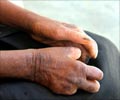Drug Controller of India and FDA approve new leprosy vaccine that was developed by NII, Delhi and being piloted in 5 districts of Bihar & Gujarat.
Highlights
- Leprosy is an infectious, disfiguring and debilitating disease existing since 300 BC
- A completely curable disease that should be treated early with Multi-Drug Therapy (MDT)
- New vaccine Mycobacterium indicus pranii (MIP) to be launched as a preventive measure
- Awareness of this disease and health education play a huge role in early identification of this disease.
Facts about Leprosy Vaccine
- The first leprosy vaccine ICRC that was prepared by the Cancer Research Institute in Mumbai in 1979.
- The new leprosy vaccine is called Mycobacterium indices pranii (MIP)
- Launching on a pilot basis it will cover five districts in Bihar and Gujarat
- If the results of the vaccine coverage hold good, then the vaccine will be extended to other highly prevalent states in our country.
- The vaccine is aimed at preventing disease among close contact with those infected by leprosy
- Clinical trials have shown that the vaccine has the potential to reduce new cases by 60% in the next 3 years and it also has an increased cure rate in those cases with skin lesions.
Leprosy is an infectious disfiguring and debilitating disease existing for decades with cases recorded in history dating back to 300 BC.
The causative organism Mycobacterium leprae was discovered only in 1873 by a Norwegian Scientist Dry Gerhard Armauer Hansen hence also called the Hansen disease. Disease is mentioned as Kushta Rog in the texts of Charaka samhitha.
Stigma in Leprosy
The disfiguring nature of the disease caused great stigma to victims.
The diseased was believed to have received punishment for his sinful behavior and immoral character resulting in them being spurned to the streets where they were reduced to beggars seeking alms and shelter from the temple nearby.
During the British Raj, sanatoriums were built away from the cities, run by missionaries for chronic care of those affected by leprosy, tuberculosis and insanity and the diseased were called lepers synonymous to untouchables.
- The Indian Lepers Act 1898 which gave authority to arrest a leper, if seen begging for alms or on the streets.
- Indian Railways Act 1989 - refused to carry a person suffering from leprosy.
- Under the Marriage Act the spouse could seek separation, if his/her partner suffered from a virulent and incurable form of leprosy.
- It was by mid 20th century that cure to leprosy was discovered and this was followed by repealing the Lepers Act in 1985.
Due to natural immunity leprosy manifests only in 1% of the individuals who are exposed to untreated infected individuals over a long period of time.
- Transmission is through respiratory droplet
- The earliest symptoms are hypo pigmented (white) patches on the skin with a lack of sensation.
- Progressing to nerve damage, numbness and loss of sensation
- Neglected injuries and infected ulcers on the hands and feet
- Deformity like clawed finger, foot-drop and paralysis of eyelids.
- Two types of the disease either Paucibacillary (PB) leprosy or Multibacillary (MB) leprosy are a more severe form.
- When body’s immune cells attempt to prevent the spread of infection to the rest of the body
- Affecting the hair follicles, sweat glands, and nerves resulting in dry skin with discoloration, loss of sensation and enlarged nerves.
- More contagious and severe it weakens the immune system and multiplies in the body
- Large nodules or lesions across the body and face leading to disfigurement.
- Early identification and prompt treatment with Multi Drug Therapy
- Limiting the disability caused due to nerve damage by reconstructive surgeries
- Teaching self-care to patients with nerve damage to prevent further ulceration and secondary infections.
- Multi-drug therapy (MDT) consists of rifampicin, dapsone, clofazimine which are taken for 6-12 months. The very first dosage kills 99.9% bacteria in the body.
- This treatment is available free of cost at all the government hospitals from Primary health center in India.
Elimination of leprosy was achieved by India in December 2005
The recent WHO 2014 Global Update statistics shows:
- 58 % of the new cases in the world are from the Indian subcontinent and 52.8% are MB cases
- 9% new cases among children and 37% among women
- 4.6% new cases are with grade 2 disabilities (cases that have been detected late)
- 95.9% and 90.4% cure rates achieved in PB and MB cases respectively
- Prevalence in India is 0.68 per 10000 population
Partner organizations and NGOs supporting the government and working for the welfare of those affected by leprosy who still remain to victims of discrimination in the community.
Awareness of this disease and health education play a huge role in early identification of this disease. Prompt treatment achieves high cure rates and prevents further spread and complications.
The new leprosy vaccine is an effort in this direction.
References:
- The Leprosy Mission Trust of India - (http://tlmindia.org/)
- National Leprosy Eradication Programme - (http://nlep.nic.in/)
- History of Leprosy Sanatorium in India - (https://www.lepra.org.uk/platforms/lepra/files/lr/June10/Lep150-159.pdf)
- Global Leprosy Update - (http://www.who.int/wer/2015/wer9036.pdf)
Source-Medindia












